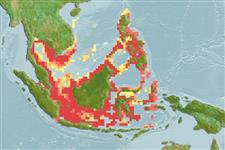>
Clupeiformes (Herrings) >
Dorosomatidae (Gizzard shads and sardinellas)
Etymology: Herklotsichthys: After Janus Adrian Herklots, Australian ichthyologist, 1820-1872.
Eponymy: Dr Geoffrey Alton Craig Herklots (1902–1986) was a British biologist, botanist and ornithologist at the University of Hong Kong (1928–1941). [...] (Ref. 128868), visit book page.
More on author: Bleeker.
Environment: milieu / climate zone / depth range / distribution range
Ökologie
seewasser; brackwasser; tiefenbereich 0 - 50 m (Ref. 188). Tropical; 20°N - 9°S, 98°E - 129°E (Ref. 188)
Western Central Pacific: Gulf of Thailand, Philippines, and Indonesia.
Size / Gewicht / Alter
Maturity: Lm ? range ? - ? cm
Max length : 8.5 cm SL Männchen/unbestimmt; (Ref. 188); common length : 7.0 cm SL Männchen/unbestimmt; (Ref. 188)
Rückenflossenstacheln (insgesamt) : 0; Rückenflossenweichstrahlen (insgesamt) : 13 - 21; Afterflossenstacheln: 0; Afterflossenweichstrahlen: 12 - 23. Immediately distinguished from all other species of Herklotsichthys by the presence of two dark saddle-like blotches on the back, at the hind part of the dorsal fin base and a short distance behind this. Overlaps range of H. quadrimaculatus, which lacks the black saddles and has elongate wing-like scales underneath the normal paired pre-dorsal scales.
A schooling species found in coastal waters. Uncommon.
Life cycle and mating behavior
Geschlechtsreife | Fortpflanzung | Ablaichen | Eier | Fecundity | Larven
Whitehead, P.J.P., 1985. FAO Species Catalogue. Vol. 7. Clupeoid fishes of the world (suborder Clupeoidei). An annotated and illustrated catalogue of the herrings, sardines, pilchards, sprats, shads, anchovies and wolf-herrings. FAO Fish. Synop. 125(7/1):1-303. Rome: FAO. (Ref. 188)
IUCN Rote Liste Status (Ref. 130435: Version 2024-2)
Bedrohung für Menschen
Harmless
Nutzung durch Menschen
Fischereien: kleinfischerei
Tools
Zusatzinformationen
Download XML
Internet Quellen
Estimates based on models
Preferred temperature (Ref.
123201): 28.1 - 29.1, mean 28.8 °C (based on 416 cells).
Phylogenetic diversity index (Ref.
82804): PD
50 = 0.5002 [Uniqueness, from 0.5 = low to 2.0 = high].
Bayesian length-weight: a=0.00871 (0.00415 - 0.01826), b=3.06 (2.89 - 3.23), in cm total length, based on LWR estimates for this (Sub)family-body shape (Ref.
93245).
Trophic level (Ref.
69278): 3.1 ±0.3 se; based on size and trophs of closest relatives
Widerstandsfähigkeit (Ref.
120179): hoch, Verdopplung der Population dauert weniger als 15 Monate. (Preliminary K or Fecundity.).
Fishing Vulnerability (Ref.
59153): Low vulnerability (10 of 100).
Nutrients (Ref.
124155): Calcium = 432 [241, 922] mg/100g; Iron = 2.84 [1.70, 4.82] mg/100g; Protein = 18.9 [17.8, 19.9] %; Omega3 = 0.51 [0.26, 0.98] g/100g; Selenium = 37.8 [17.6, 79.0] μg/100g; VitaminA = 39.8 [16.7, 90.4] μg/100g; Zinc = 2.34 [1.61, 3.50] mg/100g (wet weight);
